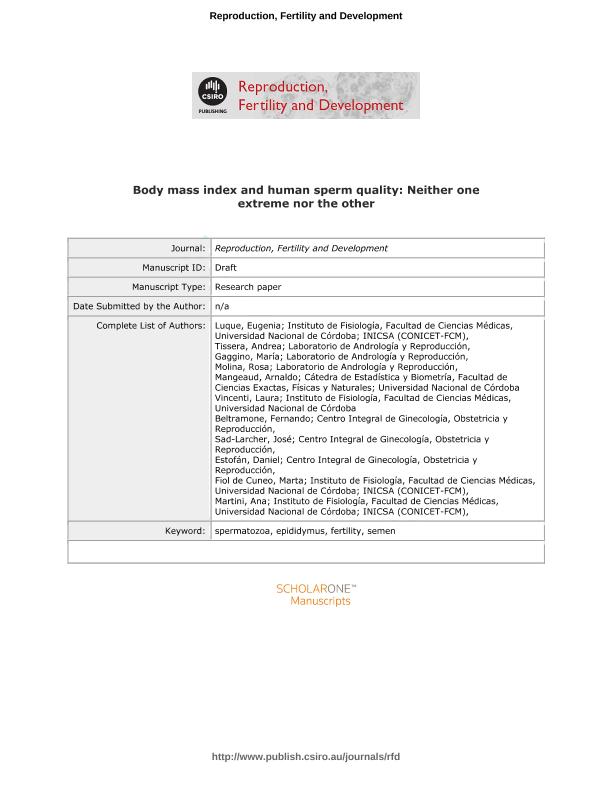Artículo
Body mass index and human sperm quality: Neither one extreme nor the other
Luque, Eugenia Mercedes ; Tissera, Andrea D.; Gaggino, M. P.; Molina, Rosa I.; Mangeaud, Adolfo; Vincenti, Laura María; Beltramone, Fernando; Sad Larcher, José; Estofán, Daniel; Fiol De Cuneo, Marta; Martini, Ana Carolina
; Tissera, Andrea D.; Gaggino, M. P.; Molina, Rosa I.; Mangeaud, Adolfo; Vincenti, Laura María; Beltramone, Fernando; Sad Larcher, José; Estofán, Daniel; Fiol De Cuneo, Marta; Martini, Ana Carolina
 ; Tissera, Andrea D.; Gaggino, M. P.; Molina, Rosa I.; Mangeaud, Adolfo; Vincenti, Laura María; Beltramone, Fernando; Sad Larcher, José; Estofán, Daniel; Fiol De Cuneo, Marta; Martini, Ana Carolina
; Tissera, Andrea D.; Gaggino, M. P.; Molina, Rosa I.; Mangeaud, Adolfo; Vincenti, Laura María; Beltramone, Fernando; Sad Larcher, José; Estofán, Daniel; Fiol De Cuneo, Marta; Martini, Ana Carolina
Fecha de publicación:
12/2015
Editorial:
Csiro Publishing
Revista:
Reproduction Fertility and Development
ISSN:
1031-3613
e-ISSN:
1448-5990
Idioma:
Inglés
Tipo de recurso:
Artículo publicado
Clasificación temática:
Resumen
The aim of the present study was to investigate the still contentious association between body mass index (BMI) and seminal quality. To this end, 4860 male patients (aged 18-65 years; non-smokers and non-drinkers), were classified according to BMI as either underweight (UW; BMI <20kgm-2; n≤45), normal weight (NW; BMI 20-24.9kgm-2; n≤1330), overweight (OW; BMI 25-29.9kgm-2; n≤2493), obese (OB; BMI 30-39.9kgm-2; n≤926) or morbidly obese (MOB; BMI ≥40kgm-2; n≤57). Conventional semen parameters and seminal concentrations of fructose, citric acid and neutral -glucosidase (NAG) were evaluated. The four parameters that reflect epididymal maturation were significantly lower in the UW and MOB groups compared with NW, OW and OB groups: sperm concentration, total sperm count (103.3±11.4 and 121.5±20.6 and vs 157.9±3.6, 152.4±2.7 or 142.1±4.3 spermatozoa ejaculate-1 respectively, P<0.05), motility (41.8±2.5 and 42.6±2.6 vs 47.8±0.5, 48.0±0.4 or 46.3±0.6 % of motile spermatozoa respectively, P<0.05) and NAG (45.2±6.6 and 60.1±7.9 vs 71.5±1.9, 64.7±1.3 or 63.1±2.1 mU ejaculate-1 respectively, P<0.05). Moreover, the percentage of morphologically normal spermatozoa was decreased in the MOB group compared with the UW, NW, OW and OB groups (4.8±0.6% vs 6.0±0.8%, 6.9±0.1%, 6.8±0.1 and 6.4±0.2%, respectively; P<0.05). In addition, men in the MOB group had an increased risk (2.3-to 4.9-fold greater) of suffering oligospermia and teratospermia (P<0.05). Both morbid obesity and being underweight have a negative effect on sperm quality, particularly epididymal maturation. These results show the importance of an adequate or normal bodyweight as the natural best option for fertility, with both extremes of the BMI scale as negative prognostic factors.
Archivos asociados
Licencia
Identificadores
Colecciones
Articulos(INICSA)
Articulos de INSTITUTO DE INVESTIGACIONES EN CIENCIAS DE LA SALUD
Articulos de INSTITUTO DE INVESTIGACIONES EN CIENCIAS DE LA SALUD
Citación
Luque, Eugenia Mercedes; Tissera, Andrea D.; Gaggino, M. P.; Molina, Rosa I.; Mangeaud, Adolfo; et al.; Body mass index and human sperm quality: Neither one extreme nor the other; Csiro Publishing; Reproduction Fertility and Development; 29; 4; 12-2015; 731-739
Compartir
Altmétricas



